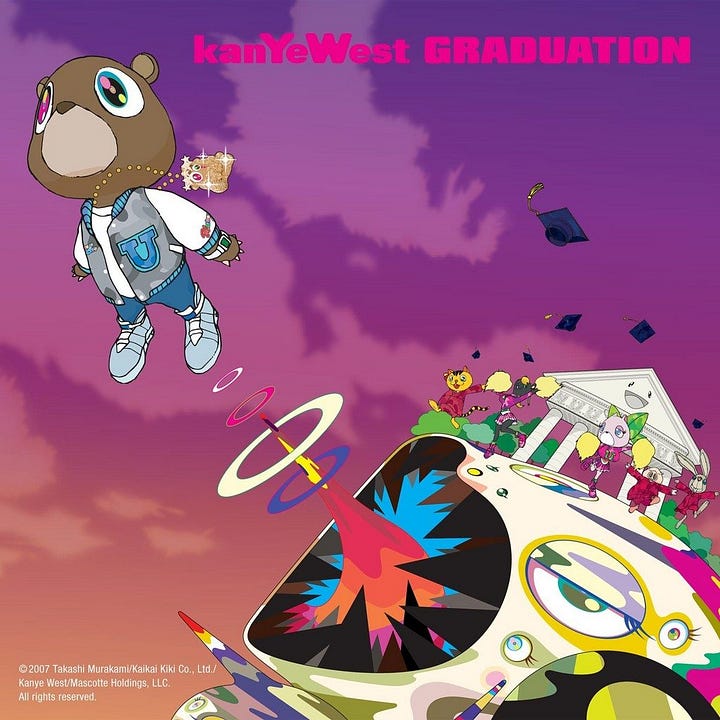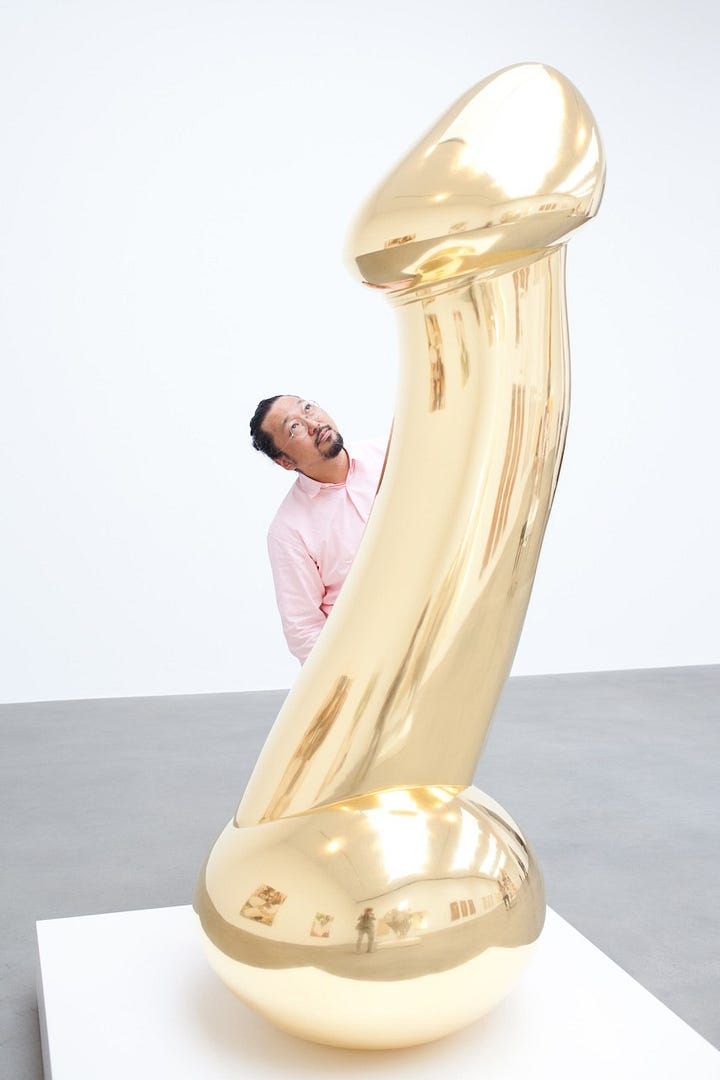Shu-ha-ri
An OG Japanese model of the process of learning.
While it has its roots in martial arts, the concept can be applied to various disciplines because it delves into the essence of being a beginner learning, the process to mastery and finally breaking out into “transcending”.
This is an evolution we take all the time the moment we decide to learn something.
A more known model used in the west is the 4 stages of competence.
Where you going from not knowing you suck at something, until you reach automatic mastery of something.
Shuhari is essentially the “how to” reach these levels of competences in an actionable way.
We’ll use Takashi Murakami, a contemporary Japanese artist known for his unique blend of traditional Japanese art with pop culture. You’ve probably seen a good amount of his work whether you come from the traditional contemporary art work or the new web3 digital art world.
But we’ll get to those examples -
👇🏼👇🏼👇🏼
Shu (守) – Learn: Embracing Foundations
In the "Shu" phase, the learner adheres to foundational teachings, absorbing techniques and principles from established traditions.
This is where you spend your time studying the masters. This is our academic years. Where we study at university or conservatory. Where we go find a mentor who we admire and study with to learn the ropes of the craft we seek to master.
Now, we have youtube university or online gurus or God Lite (AI) to help us learn the fundamentals and give us a curated list of resources so we have a structured way of learning the process of learning.
This is the intern phase. You’ll be doing a lot of the boring and fundamental work here.
Murakami in the Shu Phase:
Traditional Training: Murakami pursued a doctorate in Nihonga, a traditional Japanese painting style. His early works, like "Sea Breeze" (1992), reflect this classical training.
Exploration of Otaku Culture: Even as he trained in Nihonga, Murakami became deeply interested in Otaku culture, the obsessive fandom of anime and manga in Japan.
Ha (破) – Detach: Breaking with Tradition
The "Ha" phase sees the learner breaking away from strict traditions, challenging and adapting them based on personal insights and experiences.
After we spent years learning and reach a form of mastery, learning all the rules and fundamentals, we begin to look outward.
This is like when you’re in a relationship for a while and you start debating if you should ask your partner to be in an open relationship to spice things up.
(not always the greatest idea but you never know unless you have the convo)
This is where we can take inspirations from all our other sources we consume to help inspire our mastery/creation.
As mentioned in the Shu section, Murakami already had a love for Otaku culture of anime & manga. While he wasn’t creating that art yet, he was inspired by it and consuming it. So now that he mastered the fundamentals he can draw from that source of knowledge to help him create something new.
Murakami in the Ha Phase:
Birth of Superflat: In the late 1990s, Murakami introduced the concept of "Superflat." This style and movement merged traditional Japanese art with contemporary themes from manga and anime. Works like "727" (1996) exemplify this phase.
Collaborations and Pop Culture: Murakami began collaborating with fashion brands and pop icons, most notably with Louis Vuitton and Kanye West. These collaborations, like the famous LV monogram in Murakami's style, showcased his departure from traditional art boundaries.
It’s honestly just banger work.

Ri (離) – Transcend: Mastery and Innovation
In the "Ri" phase, the learner transcends established teachings, creating a unique style or approach, often becoming a trailblazer in their field.
This is breaking all the rules. We’ve experimented and fucked around so much that we found our own lane.
This is where you truly become an artist.
Where you truly listen to yourself and allow yourself to create freely.
Murakami in the Ri Phase:
Kawaii Culture and Dark Themes: Murakami's works began to juxtapose Japan's "kawaii" (cute) culture with darker themes. Pieces like "Flower Matango" (2001-2006) and "Korin: Azure River" (2016) showcase this duality.
But he also showed a more provocative side that really poked at hyper sexualization found in otaku culture & in general of media.
Mans even presented a giant gold dick as the Gagosian gallery
(if you don’t know this is like “the” art gallery for the super elite and the culture tastemaker)

Global Recognition and Expansion: With exhibitions worldwide and ventures like the Kaikai Kiki Co., Ltd., Murakami established himself as a global art powerhouse, influencing artists and pop culture internationally. He began to experiment with NFT’s and digital art.
1. He partnered with RTFKT to launch CloneX
2. He also launched his Murakami Flower collection and gamified lucky cat game on the blockchain.
3. He also launched a full digital art gallery in NYC last year.




He went beyond what was “traditional” and normal for an artist and decided to not only create his own genre of art via superflat or this kawaii + hypersex blend, but he also went into the digital art world which is unheard of still in the mainstream.
Murakami is just now at a level that because of his uniqueness he is a household name in the contemporary art world. He is a cultural staple and now a trendsetter.
He’s transcended into legacy artist status.
He’s just that guy.
TLDR: How to learn
1. Learn fundamentals from a teacher or mentor or school.
Teachers who have already done it or are where you would like to be, will have resources and curated a list of knowledge to help you also achieve your goal or at least get you started so you can begin learning yourself after by knowing what you should be looking up/researching.
2. Practice, practice, practice
(this takes a lot of time - usually years & where most people give up because no dopamine or sign of rewards for a while & it feels bad)
Pro-tip: As a musician who spent years in a practice practicing for 8+ hours a day for my entire life basically — make practice easy for yourself.
How?
Remove any barriers possible to practice (example: I always kept my cello outside it’s case because if I kept it inside the case in my room, I’d be too lazy to take it out, so I had no excuse if it was just out and easy to play)
Environment is everything. Surround yourself with others who are on the same track or doing what you want to do - a community - so whenever you see them doing something you want to act also. It’s social peer pressure.
At conservatory I lived in a house with all musicians. The moment one of us heard someone else practicing in the house, we knew we should practice. We kept each other motivated, reminded each other with action, and also got feedback to improve faster.
For most people, I say find discord communities or online projects or in-person groups to meet up and keep you motivated.
3. Once you’ve reached mastery and have practiced a ton & can make a living for yourself based on your craft - you’ve reached the point of reflection.
You’ll know you reached this point once you exit survival mode & can monetize your skills. But you’ll start to think about whether you like what you do & enter existential questioning about everything.
(means you got time to think for real)
What would you like to do? What’s the ideal? What are you creating? Who are you working with?
This questioning phase leads to experimentation, to fuck around and find out.
This is where you start listening to your inner gut and intuition more - and really seeing what is sustainable for you + something you enjoy + are good at.
This is where you showcase the blend of the unique human experiences and perspective you have.
This is the artist part. This is where your story sharing begins.
Now…
Are you ready for the journey?









